Window treatments for sliding glass doors
Posted
on December 13, 2016
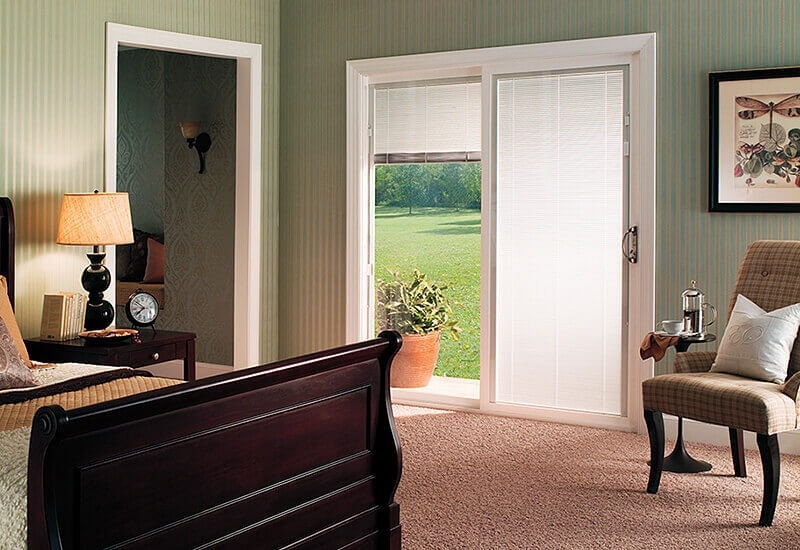
Unlike hinged doors, treatments cannot be adhered directly to the door panel with sliding glass doors. This can limit your options, but there are plenty of good choices available to homeowners when it comes to treatments for sliding glass doors. In this article, we'll discuss the pros and cons of several different coverings for sliding glass doors, so you can make the decision that's best for your home.
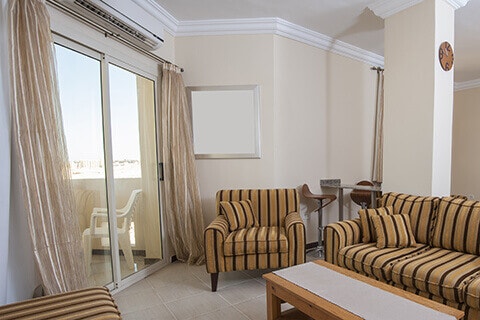
Curtains
Simple, relatively inexpensive, and available in almost unlimited colors and styles, curtains are one of the most popular options for a sliding glass door covering. The price of curtains for sliding glass patio doors will vary based on the wide variety of fabric types and thicknesses available on the market today.
Pros:
- Easy to install and replace. Do it yourself with just one trip to your local home improvement store and a few tools.
- Endless options when it comes to colors, patterns, and sheerness. Curtains let you customize the look as well as the level of light that is filtered.
- Most curtain fabrics are easy to clean on a regular basis, either by putting them in your washing machine at home or taking them to the dry cleaner.
- Sheer curtains can give you privacy while still letting sunlight in.
Cons:
- If you do not want any sunlight to come in, curtains may not live up to your standards. Unless you buy very thick curtains that go all the way to the floor, some sunlight will come through.
- For the most part, curtains need to be either drawn or closed, there is not as much flexibility to partially close or tilt that you might have with blinds.
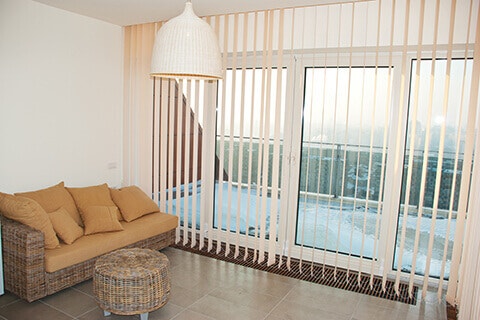
Vertical blinds
Vertical blinds are another popular option and are among the most affordable options for sliding doors.
Pros:
- Vertical blinds are easy to clean. All you need to do is wipe them with a damp cloth.
- This type of blind can be configured to draw from the left, right, or split in the middle. When drawn, vertical blinds move almost completely out of the way.
- Available in very wide widths to cover large doors.
- You can adjust vertical blinds to decide how much sunlight you want to let in by tilting the vanes (the long vertical pieces that make up vertical blinds), and when they completely closed, they are very good at keeping all sunlight out.
Cons:
- You may not be able to install blinds yourself, so installation cost should be figured into the overall expense.
- They can be noisy when blown by wind or when operated.
- Lower quality blinds may not be as resilient and can be prone to breaking or cracking, however you may be able to easily replace broken slats if damaged.
- Many people think vertical blinds are not as elegant and attractive to look at, compared to other patio door coverings.
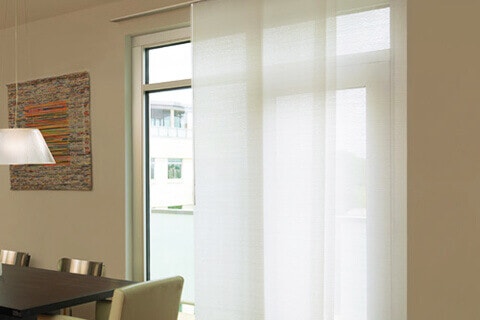
Sliding panel systems
The modern cousin of vertical blinds, this option is great for those seeking a contemporary look.
Pros:
- A more modern take on vertical blinds, this system consists of larger panels that operate on a sliding track above the entry.
- Available in a variety of fabrics and materials offering versatility on opacity.
- The header track is slimmer than traditional vertical blinds, giving a more contemporary look.
Cons:
- The modern look of these systems may not mesh well with your decor.
- Less versatility than vertical blinds as the panels do not tilt or rotate.
- When open, the stack of panels is much larger than traditional vertical blinds.
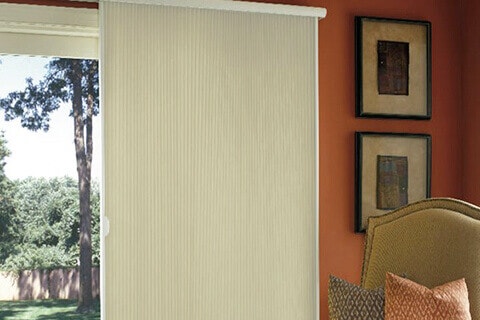
Vertical cellular shades
Vertical shades are a less common choice for sliding glide glass door treatments and may come with the largest price tag.
Pros:
- Shades designed for sliding glass doors can provide extra insulation from the heat or the cold, because they fill the entire door frame.
- If your windows have cellular shades, this option can provide a consistent look by matching the horizontal honeycomb pattern of your window treatments.
- Shades are easy to use; you simply pull them out when you want the patio door covered and push them back when you want it uncovered.
Cons:
- Unless you add a room darkener to the side that faces outward, most shades will still let some light in. This might not be the best option if darkening the room is your first priority.
- Shades are not easy to clean when they get dirty. Any stains, even if they are faint, usually mean having to replace the entire shade.
- May be more susceptible to damage from rambunctious kids or pets.
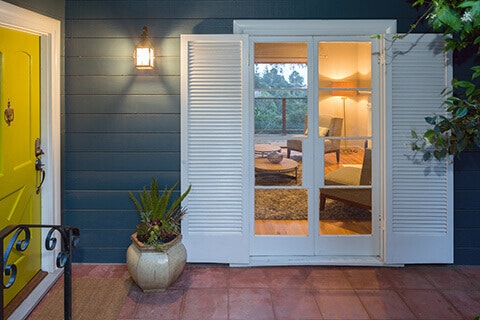
Shutters
Shutters are another uncommon choice for covering sliding glass doors, but perhaps they are a good fit for you. Shutters can be installed on a track, so they can move out of the way when you open the door.
Pros:
- Shutters allow you to decide how much light you want to let in, and they do an excellent job of keeping light out when they are completely closed.
- Shutters are easy to clean.
- When they are closed, shutters can provide good insulation from the heat or cold.
Cons:
- Shutters are probably the most cumbersome and difficult to install out of any of these options.
- Though they are easy to clean, cleaning them takes a lot of time, since shutters provide a lot of surfaces for dust to collect on.
When deciding among different patio door coverings for sliding glass doors, consider insulation, easy maintenance and aesthetics. The type of treatment you choose should be based on your needs and the needs of your home.
Schedule a free consultation to find windows and doors for your home.
